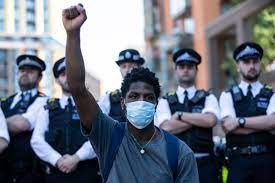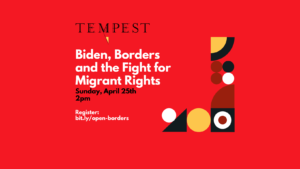
 [Editors’ note: This article will appear in the Summer 2021 issue of New Politics, which will be sent to subscribers shortly.]
[Editors’ note: This article will appear in the Summer 2021 issue of New Politics, which will be sent to subscribers shortly.]
Gilbert Achcar grew up in Lebanon and has lived and taught in Paris, Berlin, and London. He is currently professor of Development Studies and International Relations at SOAS, University of London. His many books include The Clash of Barbarisms (2002, 2006); Perilous Power: The Middle East and US Foreign Policy, co-authored with Noam Chomsky (2007); The Arabs and the Holocaust: The Arab-Israeli War of Narratives (2010); Marxism, Orientalism, Cosmopolitanism (2013); The People Want: A Radical Exploration of the Arab Uprising (2013); and Morbid Symptoms: Relapse in the Arab Uprising (2016). He was interviewed by Stephen R. Shalom for New Politics on May 5, 2021.
New Politics: Gilbert, you’ve recently published a much-discussed article in The Nation on anti-imperialism.[1] I wonder if we could begin with you telling us why you wrote the article and briefly summarizing your argument.
Gilbert Achcar: Thank you, Steve. I wrote this article because of the big confusion that exists nowadays on the left on the meaning of “anti-imperialism.” I believe that this confusion is primarily a result of the sea change in the global situation that followed the collapse of the USSR. There has also been a change in the type of wars waged in the global South. Imperialist wars against national liberation movements or regimes are no longer the predominant type, as in the first decades after the Second World War. Since the 1990s we have seen imperialist wars against oppressive regimes such as in Iraq, the Balkans, and Afghanistan. The situation got yet more complicated with what has been called the Arab Spring in 2011. Western imperialist powers — Barack Obama’s United States in the first place — appeared as if supportive of the popular uprisings against dictatorial regimes.
So, what does it mean to be an anti-imperialist in this new international environment? That’s the issue I tackle in the article, as a result of my long personal involvement in such debates, starting most crucially from 2011 on the issue of Libya, and then later on Syria. My original title was “Their anti-imperialism and ours.”[2] I formulated three basic principles of what constitutes truly progressive anti-imperialism in my view, principles that ought to be rather elementary for anyone on the left, whatever their ideological orientation, Marxist, anarchist, or whatever, provided they adhere to the most elementary principle of a true left, which is democracy. People who agree on these principles can discuss anti-imperialist tactics. Some, however, discard them. I call these people “neo-campists” because they are no longer systematically aligned behind a single specific state or “socialist camp” as were the campists of the time of the USSR, but determine their positions negatively, through kneejerk opposition to anything the US or UK governments do and sympathy for whoever the two governments oppose, including despotic regimes and Russia’s rival imperialism. The neo-campists are most often incapable of engaging in discussion without resorting to invective and calumny. I concluded my article with this observation, and indeed, no sooner was it out than various neo-campists rushed to confirm it.
Now, what are the three principles? The first relates to that most elementary democratic principle that I already mentioned. When it comes to international politics, to be on the left means, first of all, to support the peoples’ right to self-determination. That should be the starting point in defining a truly progressive anti-imperialism. Crucially, this starting point is not opposition per se to this or that imperialist state. It is rather the defense of the people’s right to self-determination: it is because imperialist states, by definition, trample upon this right that they must be countered.
The second principle is that anti-imperialism requires opposition to all imperialist states, not standing with one against the others, or ignoring one and its victims and only focusing on the other, whichever it is. On the left in Western countries, there are neo-campists who only focus on U.S. and British imperialism, or Western imperialism in general, and ignore, at best, or even support, other imperialist states, such as Russia. You may find the reverse in Russia: progressives who are very hostile to what their government does abroad and remain silent on, if not supportive of, what Western governments do. Once one rises above the Western-centrism of much of the Western left, one understands that a truly internationalist anti-imperialist perspective is one that opposes imperialism whatever its nationality or its geographical location, West or East.
The third principle addresses exceptional cases. There might be exceptional circumstances where intervention by an imperialist power is crucial in preventing a massacre or genocide, or in preventing a popular democratic uprising from being bloodily suppressed by a dictatorship. We have seen such cases in recent years. But even then, anti-imperialists should dispel any illusions, and advocate zero trust, in the imperialist country. And they should demand that its intervention remain limited to forms, and bound by legal constraints when they exist, that do not enable the imperialist power to impose its will or determine the course of action.
This third principle explains why, in the cases of Libya and Syria, even though Western governments pretended to be on the side of democratic change against the dictatorial reactionary regime, I have been opposed to direct intervention. The only exception was at the very beginning of the UN-authorized No-Fly Zone over Libya, when I explained that, for the sake of preventing a foretold massacre, I could not oppose the intervention in its initial phase. I explained a thousand times that I never said that I supported the intervention—but, as we know, there are none so deaf as those who will not hear. All I said is that I couldn’t oppose it, which is not the same as saying I favored it, except to those who don’t know the difference between abstaining and supporting, or who prefer to deliberately ignore it because their only way of arguing is by distorting the views of those they disagree with.
The population of the second city in Libya, Benghazi—legitimately fearing for their lives, with the Libyan regime moving its far superior forces toward the city, and the dictator, Gaddafi, vowing to crush them—implored the UN for protection. Even Moscow and Beijing could not oppose this: they both abstained at the UN Security Council. But once the immediate danger was over, I stood against the continuation of NATO bombing, which went far beyond the UN mandate. My attitude became the same as the one I have held on Syria from the very start, which is to support the delivery of defensive weapons to the insurgents in order to protect the population. I would not support the delivery of weapons to an organization such as ISIS, of course, since it is as oppressive as the regime, if not more so, but I certainly support the delivery of weapons to the Kurdish forces in Syria or what used to be the Free Syrian Army before it fell under full Turkish control starting from 2016.
I am opposed to the presence of U.S. troops on the ground, even in Kurdish-dominated northeast Syria, which is where they are stationed at present. I am actually opposed to all five occupations in Syria—in chronological order: Israel, Iran and its proxies, Russia, Turkey, and the United States. Five states have troops on Syrian soil. I oppose all these occupations and support the right of the Syrian people to democratic self-determination, not the right of the murderous regime to bring in accomplices to help it massacre its own people, which is what some neo-campists support.
NP: Let me explore the three principles a little more. Critics may say something like: But what about regime change? Doesn’t the United States have a program of regime change around the world—in Ukraine, in the Balkans, in the South China Sea, and Xinjiang province? Shouldn’t we be opposed to that regime change program?
GA: “Regime change” is a phrase that was used by the Bush administration. As far as I know, it hasn’t been used since then. The phrase used by the Obama administration in the face of the Arab Spring was “orderly transition.” And that’s very different from “regime change” à la Bush. The latter means occupation of a country in order to change its type of government, usually under the pretext of bringing democracy. This is typical colonial-like domination that must be resolutely opposed—even if it were about North Korea, an appallingly totalitarian state. But “regime change” wasn’t the Obama administration’s line. Some on the left lag behind reality, always fighting the last war. U.S. imperialism’s methods and doctrine did change in the light of the Iraqi debacle, as they had previously changed after Vietnam.
“Orderly transition” might be regarded as the true Obama doctrine: it meant that no existing state should be dismantled. The state apparatus should be kept intact, instead of allowing the kind of dismantlement that the U.S. occupation implemented in Iraq, which has come to be regarded in Washington as the main reason for the subsequent debacle of the U.S. occupation. What Obama favored everywhere in the Middle East and North Africa was a compromise between the old regime and the opposition, opening the way for a transition that preserved the state’s continuity. He put pressure on Egypt’s military in 2011 for this kind of transition. He tried to steer Libyan events in that direction, but failed completely, as the state there got completely dismantled. He sponsored the Gulf monarchies’ mediation to obtain that outcome in Yemen. And that’s what he advocated for Syria, openly stating in 2012 that he supported “the Yemen solution” for that country. What was this “Yemen solution”? It was a compromise between the head of the regime and the opposition, mediated by the Gulf monarchies: The Yemeni President stepped down, handed the presidency to the Vice President, but remained in control of major levers of power in the country. That’s the “solution” that Obama favored in Syria.
Now, what has been the most important intervention of the Obama administration in Syria? To answer this question, let us compare its attitude toward the Syrian opposition to the way the United States dealt with the mujahideen who fought the Soviet occupation in Afghanistan. Washington supported the Afghan mujahideen, along with the Saudi kingdom and the Pakistani military. It is well known that it armed them with anti-aircraft missiles, Stinger missiles. Compare that to Syria. Not only did the United States not deliver any such weapons to the Syrian uprising—even in 2012, when it was still dominated by what could be described as a democratic opposition. But it even forbade all its regional allies from delivering such weapons to the Syrian insurgents. Turkey produces Stinger missiles under U.S. license, but it wasn’t allowed to deliver a single one of them to the Syrian opposition—nor were the Gulf monarchies. That was the crucial intervention of the United States in the Syrian conflict. And that is what allowed Bashar al-Assad’s regime to remain in place. It allowed him to maintain a monopoly of air power, which enabled his regime to even drop barrel-bombs from helicopters—a most indiscriminate and devastating type of bombing. Helicopters are an easy target for anti-aircraft weapons, and yet, how many helicopters have you seen shot down by the opposition in Syria? Hardly any. The reason for this U.S. intervention was, first, Israel’s opposition to the delivery of anti-aircraft missiles to the Syrian opposition, and second, Obama’s fear of creating the conditions for a rout of the Syrian regime’s forces that would have led to state collapse in the manner of what happened in Libya.
Thus, the Obama administration in fact helped Bashar al-Assad much more than it did the Syrian opposition. Iran understood this and upgraded its intervention in Syria through its proxies starting from 2013, confident that Obama wouldn’t do anything serious to prevent it or to step up qualitatively his support to the opposition. Obama confirmed this in 2013 in the way he backtracked on the famous chemical weapon “red line.” Then in 2015, Russia intervened massively in its turn. So, you have two reactionary states, Iran and Russia, intervening in the Syrian conflict on a much more massive scale than any Western power. There is no way anyone could claim the contrary, lest they completely distort the facts. Add to this that the main armed U.S. intervention in Syria, including deployment of troops on the ground, was actually on the side of the only leftwing force engaged in the Syrian conflict, which is the Kurdish movement. That’s something that neo-campism cannot fathom.
NP: Russia is a lesser imperialist power. But somebody might tell you: If there is a lesser imperialist power and a greater one, doesn’t it make sense to focus our attention on stopping the greater imperialist power?
GA: Well, that’s the logic of the lesser evil, the object of a long history of debates. However, let us consider what one means when speaking of a lesser evil. Not that it is lesser in size, but that it’s less dangerous, less vicious, less “evil” than the other. Thus, a dominant liberal capitalist force could be construed as a lesser evil than a weaker fascist one. In that light, I really don’t think that Russia is in any way a “lesser evil” than the United States. Russia crushed the Chechen people within its own territory between 1994 and 2009 in ways that are certainly no less brutal, if not more brutal, than what the United States did to Iraq during that same period. Both were huge crimes. Moreover, the Russian government is far more authoritarian and undemocratic than the U.S. government. U.S. imperialism can be stopped by mass action. Russian imperialism doesn’t allow any mass opposition to build up. So, there are several issues that make the characterization of Russia as the “lesser evil” void of meaning. And even though the Russian economy is dwarfed by those of the United States, and China for that matter, the Russian military is a much bigger part of the global military balance than the Russian economy is of the global economy, and it is increasingly aggressive in projecting its power abroad.
Look at what Russia is doing today in my part of the world—excuse me again for turning it to my part of the world and not looking at everything from the perspective of New York or London. What is Russia doing today in the Middle East and North Africa? It has played and is still playing a key role in shoring up the Syrian regime, one of the most murderous dictatorships in the region, and it is itself responsible for a good deal of the destruction and killings and carnage that have occurred in that poor country. The Russian intervention consisted mainly in aerial and missile bombing and when you know what such bombing can do—in the name of fighting ISIS, U.S. bombing in limited parts of Syria led to terrible devastation, especially in the city of Raqqa—you can imagine what was done by Russian bombing on a much larger scale, over all the territories that were under opposition control when Russia began its direct intervention in 2015, up to the present.
Since then, Russia has also been intervening in Libya, along with the Egyptian regime of Abdel Fattah Al-Sisi, and the United Arab Emirates, the region’s most reactionary states with the Saudi kingdom. Russian Wagner troops—which are even less “private” than their U.S. equivalent, the former Blackwater—have been intervening in Libya to support former CIA asset Khalifa Haftar, who has grouped around him forces ranging from remnants of the old regime to Salafists to combat the reconciliation government backed by the United Nations. Vladimir Putin has also been fully supportive of Egypt’s Marshal Sisi, from the very moment that he organized his coup, long before Trump named him his “favorite dictator.”
So, if we look at the role of Russia in my part of the world, it is certainly no better than that of the United States. In Syria, it’s definitely much worse: there, the main actions of the United States by order of importance have been fighting ISIS, supporting the Kurdish movement for that purpose, and supporting sections of the Syrian opposition, whereas the main action of Russia has been fighting the Syrian opposition to shore up the Assad regime.
NP: Let’s go back to the Libyan case. How would you describe the opposition to Gaddafi at the beginning of the uprising? Was it a jihadist opposition?
GA: Definitely not. It was a motley group of people with a wide range of ideological orientations. Keep in mind that Gaddafi seized power in 1969 and that the uprising against his rule occurred in 2011. That makes more than 40 years in power! The government in Libya was brutally repressive, no opposition whatsoever was tolerated. In 2003, it shifted abruptly into collaboration with Washington and its “war on terror.” In that context, it engaged in “extraordinary rendition” arrangements with Western governments, under which they would hand over to the Libyan government jihadi oppositionists that they held. Among those was one of the figures that would emerge later on in the uprising, a man who sued the British government for having rendered him to the Libyan government.[3] So, there were indeed some jihadists, who had been fighting the government and were regarded by Washington and its allies as terrorists. But they were only one component of a vast conglomerate of oppositionists that included different kinds of people: democrats, liberals, Muslim Brothers, and even a few leftists – the same mix that occupied Tahrir Square in Cairo, but with less dominance of Islamic forces than in Egypt.
The first election that took place after the fall of Gaddafi in 2012 was characterized by a high participation rate, a true one since people weren’t compelled to vote as in the sham elections of the past. And the big surprise was that Islamic forces received only a minority of the votes. The majority was dominated by liberals. This proves that the 2011 uprising was not dominated by jihadists. In fact, one of the key early figures of the uprising was Abdel Fattah Younes, who had been one of Gaddafi’s close companions since 1969 and was regarded as Libya’s number two. He sided with the uprising when the fighting started and got assassinated a few weeks later. The other prominent figure, a man who emerged as the chairperson of the Transitional National Council, was the minister of Justice, judge Mustafa Abdul Jalil, a man who may be described as liberal Muslim. But the opposition was very heterogeneous, of course. In an uprising against a long-standing dictatorship, it is only normal to see the full spectrum of opposition currents uniting against the regime. This is what happened in Libya, as elsewhere.
NP: Some people say that Libya was better off under Gaddafi. How do you respond to that?
GA: If things had been so good under Gaddafi, there wouldn’t have been a popular uprising. The claim that Libya was better off under Gaddafi ignores the fact that it is a country with limited population and a high oil and gas income, with a GDP per capita of 12,000 USD in 2010, with oil and gas representing two thirds of the economy and almost the totality of exports—the clearest indication of the regime’s massive failure to develop the country. The Libyan population should have been far better off than it was in 2011 when the uprising exploded. Libya is a country where you had huge regional disparities. The regime was privileging some parts of the country, those to which its own loyal constituencies belonged, and neglecting others. It squandered a lot of the country’s income in crazy weapons purchases (mainly from Western countries from 2004 on) and military adventures.
Now there are indeed some people who bring up figures such as per capita GDP, literacy rates, life expectancy and Human Development Index, to tell you that Libya was better than other African countries. But this is a very specious comparison. Why not compare Libya to the Gulf monarchies, which have similarly small populations and huge oil and gas income? Some of them achieved better figures than Libya. Let me read to you from this 2011 report by the International Crisis Group entitled “Making Sense of Libya”:
Given a population of a mere six million, many Libyans believe their country ought to resemble Dubai. Yet, years of poor planning, insufficient and piecemeal development and pervasive corruption (coming atop the crippling effects of prolonged international sanctions), have left parts of the country in a state of considerable neglect. Resentment at this is particularly strong among easterners, who rightly or wrongly believe the government has favoured other parts of the country and deliberately disadvantaged their region. Despite the country’s economic wealth, many Libyans work at least two jobs in order to survive (of which one typically is in the state sector, where wages for the most part remain pitiful). Housing shortages are acute, with an estimated 540,000 additional units needed. As public opinion generally has seen it, most of the economic opportunities that have opened up since 2003 … have remained in the hands of a narrow elite. In particular, they have been seized by Gaddafi’s own children and extended family, all of whom have accrued large fortunes across a range of businesses from the health, construction, hotel and energy sectors. These popular perceptions were recently reinforced by the disclosure of Western diplomatic assessments. According to U.S. diplomatic cables as released by WikiLeaks, Gaddafi’s children routinely benefited from the country’s wealth; one noted that it had “become common practice” for government funds to be used to promote companies controlled by his children and indicated that their companies had benefited from “considerable government financing and political backing”. In this sense, Libya has been akin to a large pressure cooker waiting to explode.[4]
Another argument that I often hear is that had NATO intervened in Syria, the country would have been like Libya today. Well, I can tell you this: There is not a single Syrian who would not wish and pray night and day for their country to be like Libya today. I mean, Libya’s situation is nothing compared to what happened in Syria: the scale of the massacres, the devastation, the displacement, etc., are incomparably more horrendous in Syria. After two years of newly acquired political freedom, Libya fell into a new civil war starting in 2014, fueled by rival foreign interventions, but it remained a low-intensity war compared to those of Syria and Yemen.
NP: Let me go back to one of your initial principles, the one about the exceptional case when massacre is impending. Is this an argument for humanitarian intervention?
GA: The concept of “humanitarian intervention” is flawed. Nobody would oppose a truly “humanitarian” intervention, such as sending troops to help after a massive earthquake. No anti-imperialist could oppose such an intervention because that would be completely absurd. I never used the phrase “humanitarian intervention” except to criticize it as a hypocritical pretext for imperialist interventions. When imperialism intervenes in a conflict, it’s never for humanitarian reasons and I’ve never ever subscribed to any illusion about that, but have consistently denounced what Noam Chomsky has called the “new military humanism.”[5]
The exceptional cases I’m talking about are when, for reasons of their own, imperialist powers sides with a popular uprising against a despotic regime, the latest such instance being the uprising against the military takeover in Myanmar. In such cases, if the popular movement decides to bear arms to defend itself from an ongoing slaughter, I support their right to get defensive weapons from wherever they can get them, even if only from imperialist powers. I even support demanding that Western governments provide such weapons. But I do not support direct intervention, be it by bombing or by dispatching troops to be deployed on the ground, all the less when this is done in violation of international law. However, if there is no other alternative to prevent an imminent large-scale massacre, I must abstain until the threat is eliminated. Abstaining means that I wouldn’t demonstrate against the intervention, as a few people did on March 19, 2011 in New York and Washington while the population in Benghazi was joyfully applauding what they perceived as their rescue. But nor would I demonstrate in support of the intervention: I would rather warn those who are rescued against having any illusions about the real intentions and designs of their momentary rescuers. That is what I did in 2011 when the intervention started in Libya. The city of Benghazi was threatened by the regime, the population of Benghazi implored the United Nations for intervention, the Security Council voted on a resolution authorizing this intervention, and Moscow and Beijing consented, albeit by abstaining rather than voting yes. That is what I explained in the March 19 interview[6] that you did with me, and nothing else. And yet, all hell broke loose in some circles of the anti-imperialist left in the U.S. and the UK, from the usual neo-campists to even some radicals who were yet to “learn to think.”[7]
For me, the original side to this debate was that it revealed the Western ethnocentrism of most of my detractors. They simply could not put themselves in the shoes of the people of Benghazi or of any part of the Arab region shaken by the 2011 revolutionary shockwave. They saw everything from the vantage point of the U.S. or its British poodle and were only interested in countering whatever their government did regardless of what was happening on the receiving end. They attacked me because they couldn’t fathom that I react politically more in unison with the Arab part of the world to which I belong (when it is directly concerned, that is) than with Britain where I happen to reside and work—my work being focused on the Middle East and North Africa. To give you but one example, on March 19, 2011, the very same day that we held our interview, the Lebanese Hezbollah—which is not exactly known to be a great friend of the United States—was holding a mass meeting in Beirut’s southern suburb, in solidarity with the Arab peoples. That was before the Syrian uprising shifted Hezbollah’s position. Here is what the party’s leader, Hassan Nasrallah, said about Libya in his long speech:
In Libya, people rose up as they did in Tunisia and Egypt. A group of young people started in Benghazi and were met with bullets and killing. People came to their support and the revolution spread from city to city, with demonstrations and civil disobedience. They were countered with bullets, planes, and tanks. War was imposed on the peaceful and civilian popular revolution. … Like you all, we saw on television planes, and tanks, and canons, and Katyusha multiple rocket launchers, aligned in a way that reminds us in Lebanon of the 1982 invasion and all Israeli wars. This war that is launched today by the Gaddafi regime on the Libyan people is the same type of war as those launched by Israel on Lebanon and Gaza. … Whoever can provide help of whatever sort to this insurgent people must provide help so that they stand up and resist in the face of destruction and massacres.
Our revolutionary brothers in Libya and our Arab peoples must know that America and the West have given the Libyan regime enough time to crush the revolution, a lot of time spent in talks and meetings. But the Libyans were steadfast, they resisted and fought, and embarrassed the world by their steadfastness and resilience. … To be sure, the situation in Libya has become very complicated with the start of the international intervention that might involve Libya in the game of nations, and this requires from the revolutionaries that they deploy their vigilance and patriotism in which we have high confidence.[8]
Note that Nasrallah actually blamed “America and the West” not for intervening, but for having been late in intervening! He was much less critical than I had been on the same day when you interviewed me. Shortly after, once the threat was over, which was achieved after a few days of intervention destroying much of Gaddafi’s planes and tanks, I clearly stated that I was against the continuation of bombing because it was obviously no longer needed to rescue any population, but had become merely an attempt by NATO to interfere in the Libyan situation and take control of it. Here is what I explained on March 31:
Opposing the no-fly zone while offering non-plausible alternatives, as many groups of the sane and true left did with the best of intentions, was unconvincing. It put the left in a weak position in the eyes of public opinion. Opposing the no-fly zone while showing no concern about the civilians, as some fringe groups did, was immoral — not to mention the attitude of those reconstructed or unreconstructed Stalinists who are upholding Gaddafi as a progressive anti-imperialist and dismissing the uprising as a US-led or al-Qaeda-led conspiracy (while resorting to Stalinist-style slanders in discussing the position of those on the left who sympathized with the Libyan uprising’s request for protection).
The no-fly zone request by the uprising should not have been opposed. Instead, we should have expressed our strong reservations on UNSC resolution 1973, and warned of any attempt to seize it as a pretext in order to further imperialist agendas. As I said the day after resolution 1973 was adopted, “without coming out against the no-fly zone, we must express defiance and advocate full vigilance in monitoring the actions of those states carrying it out, to make sure that they don’t go beyond protecting civilians as mandated by the UNSC resolution.” Our usual presumption against military interventions of imperialist states was overruled in the emergency circumstances of massacre impending, but these emergency circumstances are no longer there at present, and protecting the uprising can now be achieved in a much better way by supplying it with weapons.[9]
The other case similar to that of Libya in 2011 is when you had the surge of ISIS in 2014, crossing the border into Iraq and spreading over a huge territory on which they carried out horrible crimes, including the genocide of Yazidis in Iraq and an attempt to do the same to Kurds in both Iraq and Syria. The Kurdish-controlled city of Kobani in northeast Syria got threatened by ISIS. Washington intervened and started bombing the self-proclaimed “Islamic State.” Should anti-imperialists have been marching in Washington and London chanting “Stop U.S. intervention in Syria”? The United States was airdropping weapons to the Kurdish forces. Should anti-imperialists have opposed this? I don’t believe so. At the time of most urgent necessity to prevent a Kurdish defeat that would have opened the way for ISIS to invade Kurdish-controlled territories in Syria, one couldn’t oppose the bombing. Once the immediate danger was over, the continuation of the bombing should have been opposed, combined with the demand to provide the needed weapons to those who were fighting ISIS, especially the Kurdish and allied forces in both Syria and Iraq.
To sum up, under exceptional circumstances when there is no available alternative to prevent a large-scale massacre, intervention by imperialist powers may be a “lesser evil” as long and as far as needed to eliminate the threat. Arming a democratic uprising against a much better-equipped despotic enemy is a necessity from a truly leftist internationalist perspective. Internationalists should demand that their governments, even imperialist governments, deliver defensive weapons to the progressive side in a civil war (remember the Spanish civil war![10]). At the same time, we should advocate to those who require such aid complete mistrust in the United States and any imperialist government whatsoever. And we should oppose any form of intervention that would tie their hands and subordinate them to Washington, Moscow, or anyone else.
NP: But if I were part of a group that was facing massacre and I were offered aid and the aid came with strings, I might say these strings are rotten, but I’d rather succumb to these rotten demands and impositions than get massacred.
GA: And I would completely understand that. But my role from the outside would be to tell you: I understand your position, I understand that you are left with no choice, but I warn you of the real aims and goals of those who are providing you with what you badly need, and I urge you to do your utmost in order to maintain and preserve your full autonomy.
Notes
[1] Gilbert Achcar, “How to Avoid the Anti-Imperialism of Fools,” The Nation, April 6, 2021.
[2] Gilbert Achcar, “Their anti-imperialism and ours,” New Politics, April 18, 2021.
[3] Owen Bowcott, “Abdel Hakim Belhaj wins right to sue UK government over his kidnap,” The Guardian, Oct. 30, 2014.
[4] ICG, “Making Sense of Libya,” June 6, 2011.
[5] The New Military Humanism: Lessons from Kosovo, Monroe, ME: Common Courage Press, 1999.
[6] Gilbert Achcar, “Libyan Developments,” ZNet, Mar. 19, 2011.
[7] Leon Trotsky, “Learn to Think,” New International, vol. 4, no. 7, July 1938.
[8] http://archive.almanar.com.lb/article.php?id=22453 (in Arabic). For further English excerpts, see Stephen R. Shalom, “Nasrallah on Libya,” ZNet, 9 April 2011.
[9] Gilbert Achcar, “Barack Obama’s Libya speech and the tasks of anti-imperialists,” Le Monde diplomatique, April 4, 2011.
[10] Andreu Espasa, “Roosevelt and the Spanish Civil War,” The Volunteer, Dec. 15, 2019, https://albavolunteer.org/2019/12/roosevelt-and-the-lessons-from-the-spanish-civil-war/.
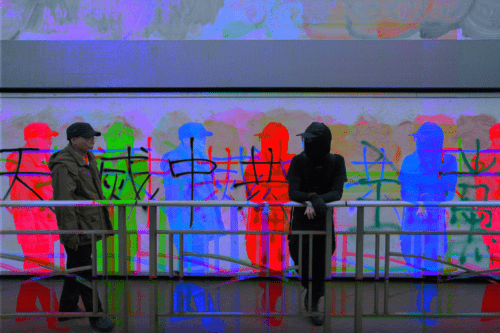
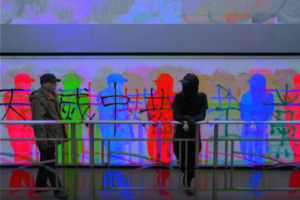 [Editor’s note: This is an original translation into English of an interview conducted with the
[Editor’s note: This is an original translation into English of an interview conducted with the 
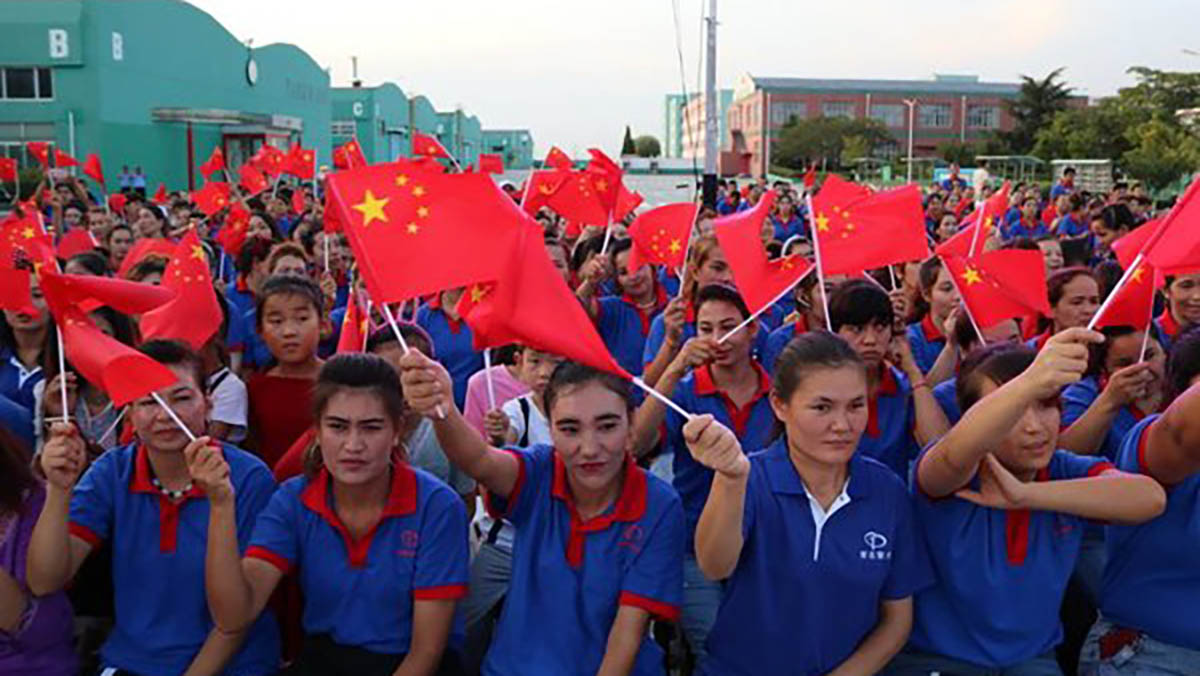
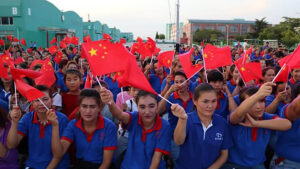 As evidence of the Chinese government’s
As evidence of the Chinese government’s 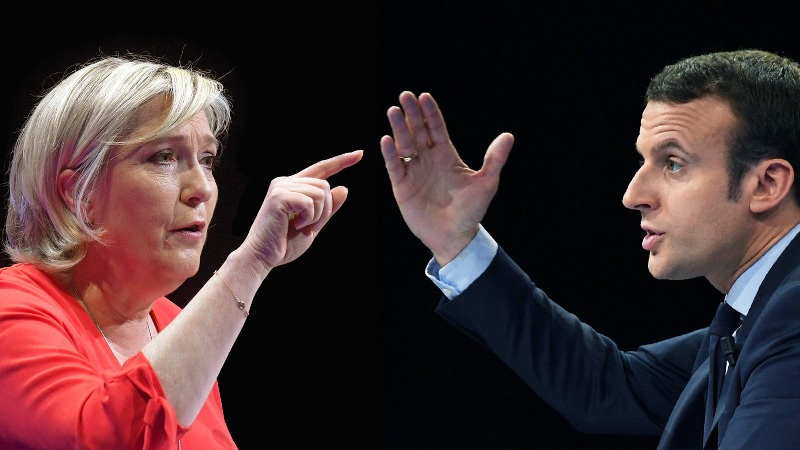
 Macron’s newest orders
Macron’s newest orders 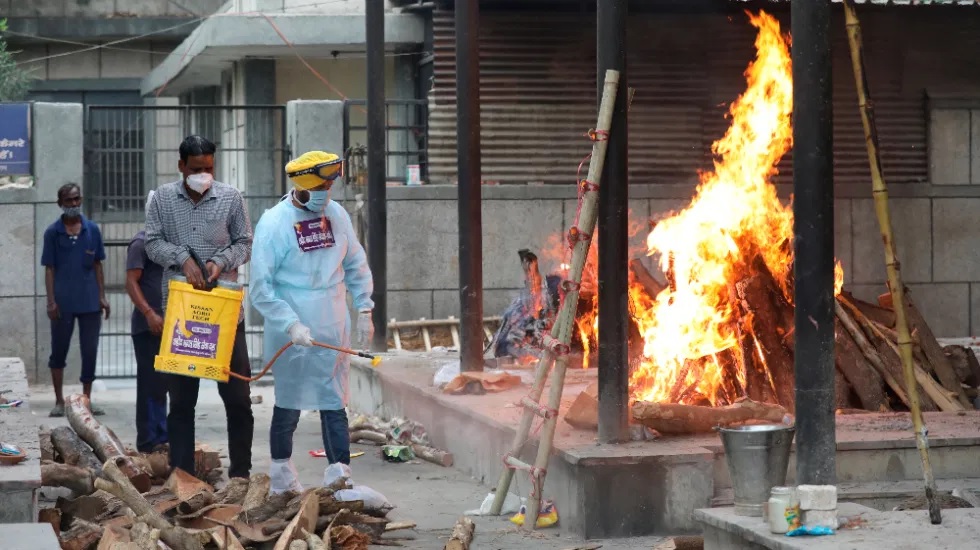
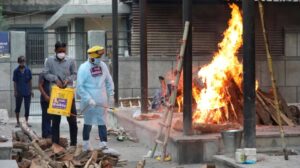 It’s hard to live in India these days, surrounded by death, fear and grief. We are inundated with heart-breaking TV reports of people begging for hospital beds and oxygen as their family members die on the pavement or in vehicles gasping for breath. Others die inside hospitals as they run out of oxygen. Equally disturbing are reports of crematorium and burial ground staff working 24/7 and still unable to get through the huge number of corpses, so that extra pyres have to be set up in parks and car parks; the massive discrepancy between those who are cremated or buried under Covid protocols and the official figures is explained by the fact that officials have been told not to write ‘Covid-19’ as the cause of death, suggesting to some experts that the real death toll may be 2 to 5 times higher than the reported figure.
It’s hard to live in India these days, surrounded by death, fear and grief. We are inundated with heart-breaking TV reports of people begging for hospital beds and oxygen as their family members die on the pavement or in vehicles gasping for breath. Others die inside hospitals as they run out of oxygen. Equally disturbing are reports of crematorium and burial ground staff working 24/7 and still unable to get through the huge number of corpses, so that extra pyres have to be set up in parks and car parks; the massive discrepancy between those who are cremated or buried under Covid protocols and the official figures is explained by the fact that officials have been told not to write ‘Covid-19’ as the cause of death, suggesting to some experts that the real death toll may be 2 to 5 times higher than the reported figure.
 This article was written for L’Anticapitaliste, the weekly newspaper of the New Anticapitalist Party (NPA) of France.
This article was written for L’Anticapitaliste, the weekly newspaper of the New Anticapitalist Party (NPA) of France.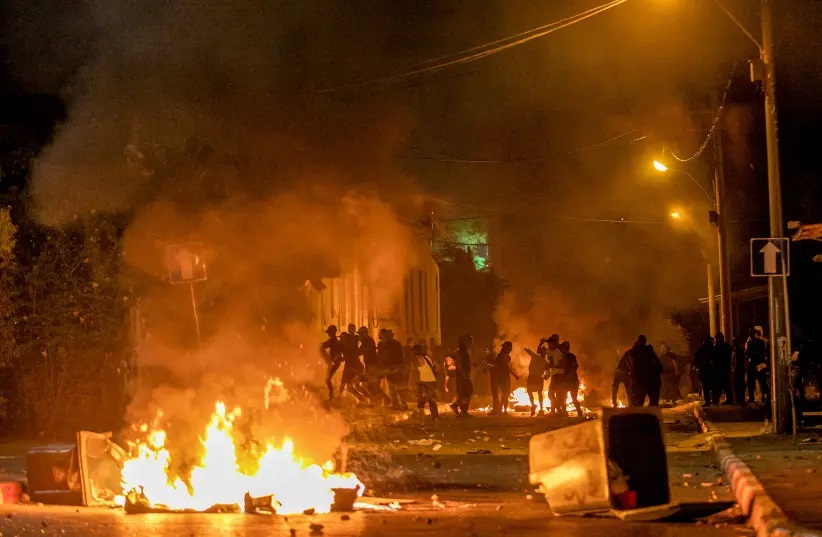
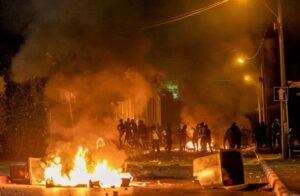
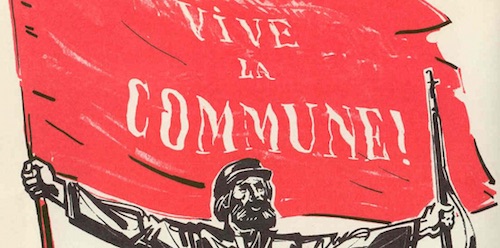
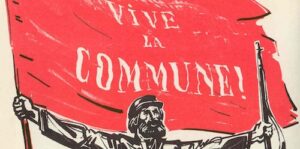
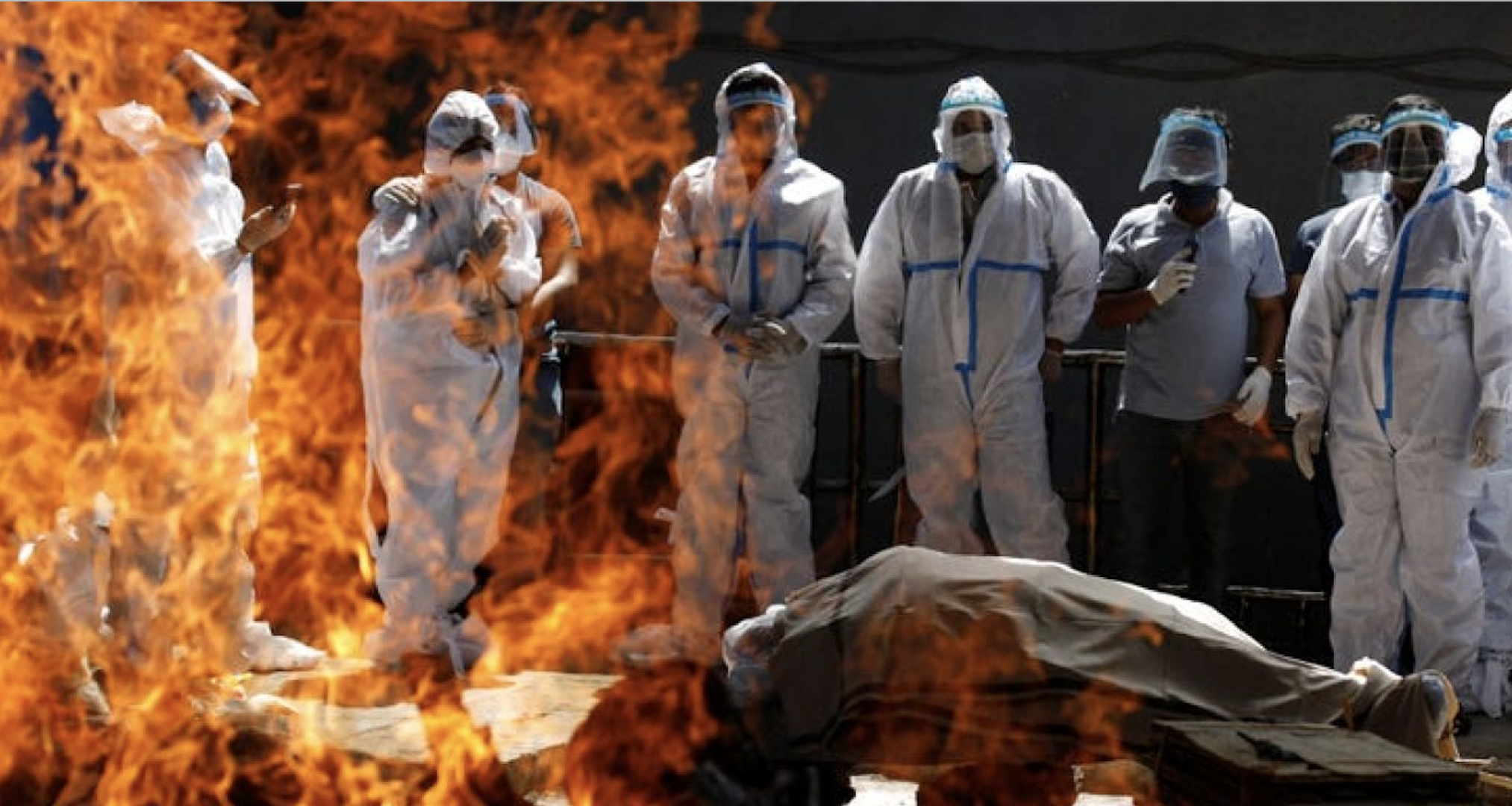
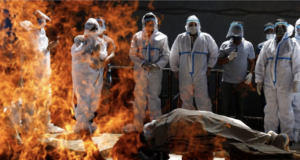 Let us be clear from the outset: what is happening in India right now is mass murder. And it is organized by a man who has
Let us be clear from the outset: what is happening in India right now is mass murder. And it is organized by a man who has 

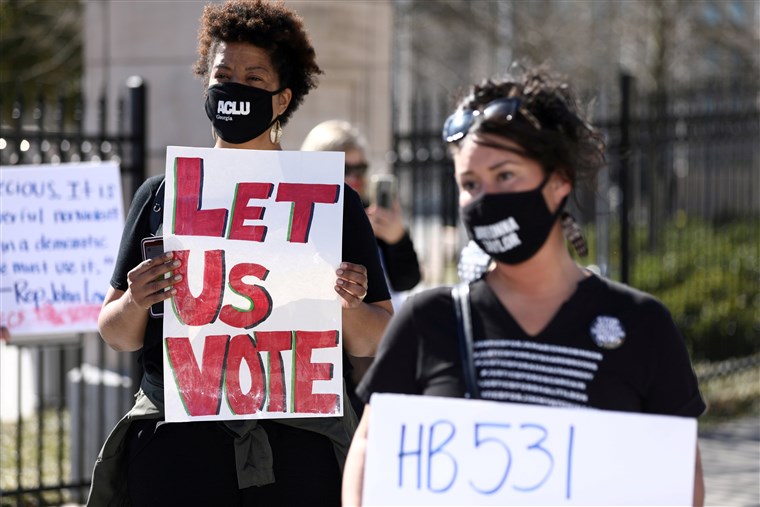
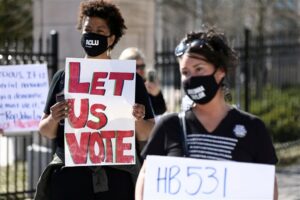 This article was written for L’Anticapitaliste, the weekly newspaper of the New Anticapitalist Party (NPA) of France.
This article was written for L’Anticapitaliste, the weekly newspaper of the New Anticapitalist Party (NPA) of France.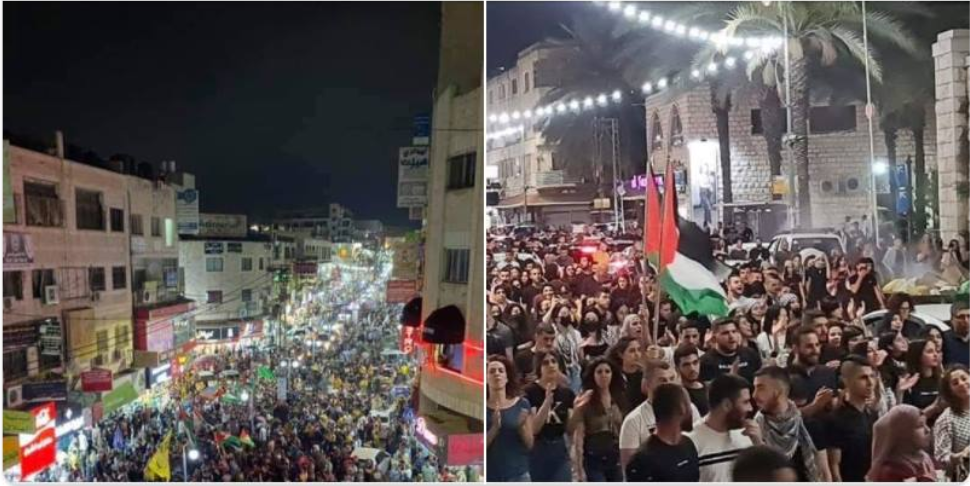
 Toufic Haddad writes: Below is unedited text of a short post I composed late last night regarding events in Jerusalem and in general. The post was doing very well with apparently several hundred shares, but within a few hours it was taken down by Facebook, and I was informed it was “Hate Speech”. I contest(ed) that accusation, but what is even more disturbing than this act of censorship, is that while I was informed by Facebook that it was ‘hate speech’, they told my audience who had reposted it that I changed the settings on it or it was deleted – with no mention of hate speech, and implying it was me who deleted it.
Toufic Haddad writes: Below is unedited text of a short post I composed late last night regarding events in Jerusalem and in general. The post was doing very well with apparently several hundred shares, but within a few hours it was taken down by Facebook, and I was informed it was “Hate Speech”. I contest(ed) that accusation, but what is even more disturbing than this act of censorship, is that while I was informed by Facebook that it was ‘hate speech’, they told my audience who had reposted it that I changed the settings on it or it was deleted – with no mention of hate speech, and implying it was me who deleted it.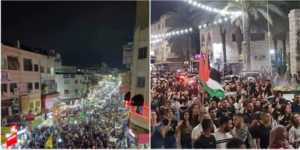
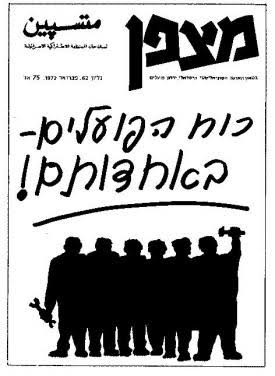
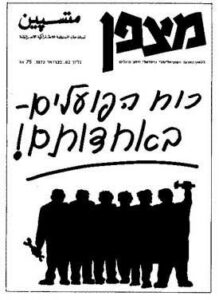






 This article was written for L’Anticapitaliste, the weekly newspaper of the New Anticapitalist Party (NPA) of France.
This article was written for L’Anticapitaliste, the weekly newspaper of the New Anticapitalist Party (NPA) of France.
 The Marxist philosopher Kai Nielsen, for many years a sponsor of New Politics, passed away on March 29 in Montreal, only a few weeks away from what would have been his 95th birthday.
The Marxist philosopher Kai Nielsen, for many years a sponsor of New Politics, passed away on March 29 in Montreal, only a few weeks away from what would have been his 95th birthday.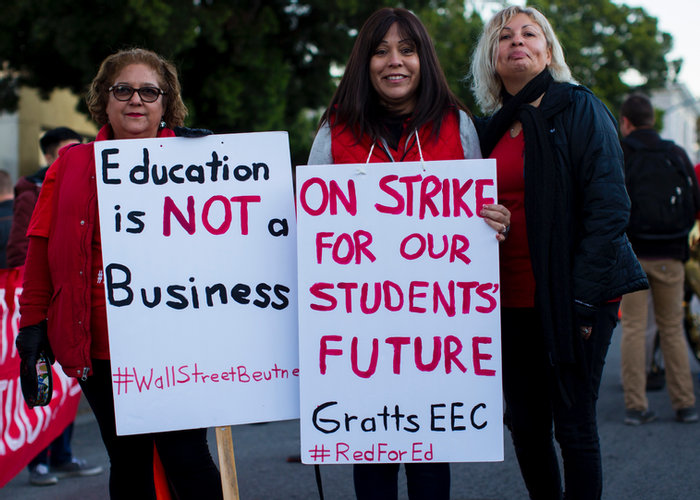
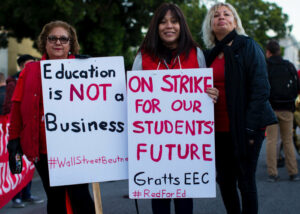






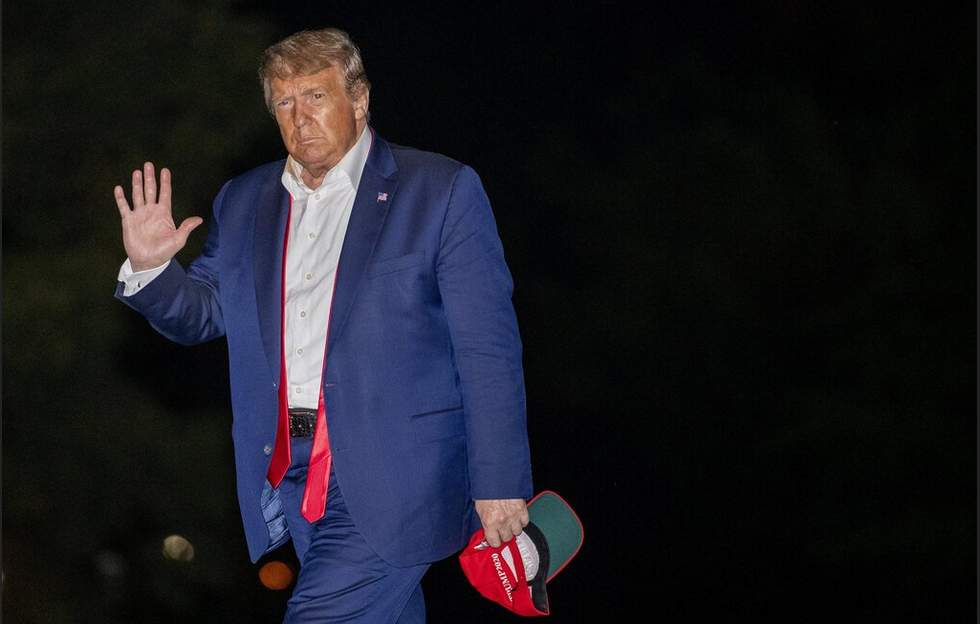
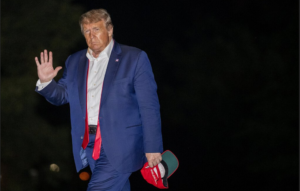 The surreal presidency of Donald Trump was filled with confusion, contradictions, anxiety, and missed opportunities. His rhetoric inflamed political tensions in every facet of American life, from football to COVID-19. Corporate media split along party lines as never before and accentuated all the ugliest aspects of American society. It seemed like anything was possible, up to and including civil war.
The surreal presidency of Donald Trump was filled with confusion, contradictions, anxiety, and missed opportunities. His rhetoric inflamed political tensions in every facet of American life, from football to COVID-19. Corporate media split along party lines as never before and accentuated all the ugliest aspects of American society. It seemed like anything was possible, up to and including civil war.